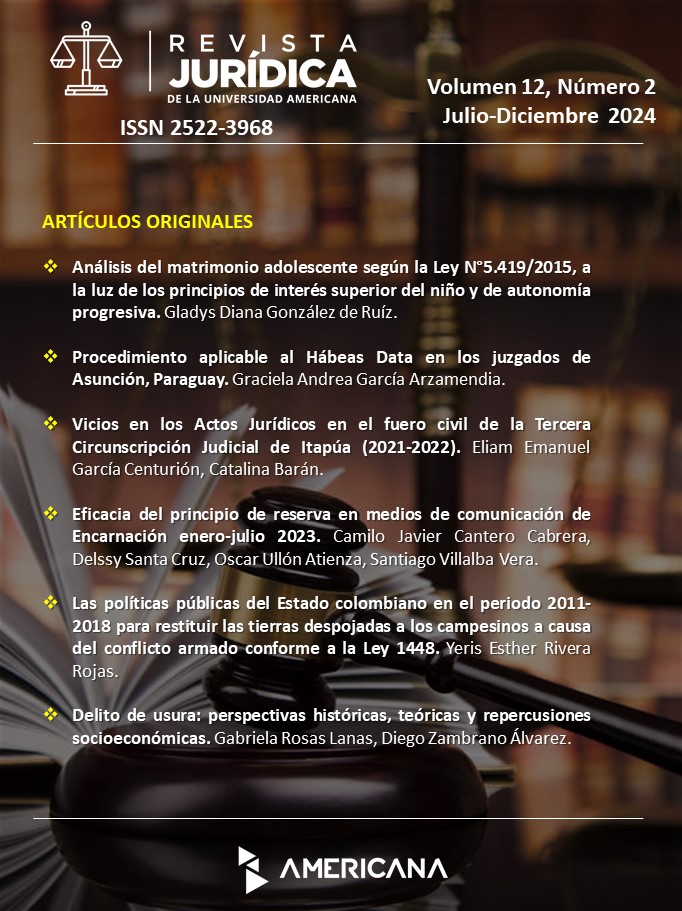The public policies of the Colombian State in the period 2011-2018 to restore lands dispossessed from peasants due to the armed conflict in accordance with Law 1448
DOI:
https://doi.org/10.30545/juridica.2024.jul-dic.5Keywords:
Conflict, dispossessed, rights, restitution, peace, peasantAbstract
The armed conflict in Colombia has been part of its history for more than 50 years, causing massive displacements in different communities, but mainly in the peasant community, which represents 30% of the Colombian population. The present research work focuses on the study of the public policies of the Colombian State in the period 2011-2018 to restore the lands dispossessed from peasants due to the armed conflict in accordance with Law 1448, for this, legislation was used. national and international laws that govern the rights of peasants, as well as competent authorities and experts on the subject. The methodology used is qualitative with interviews with experts. The results indicate the need for greater presence and commitment on the part of the Colombian State in order to comply with the guarantees established in Law 1448 of 2011, thus allowing the absolute enjoyment of their lands without concern that they may again be dispossessed or repressed by the violence.
Downloads
References
Amnistía Internacional. (s. f.). La Ley de Víctimas y de Restitución de Tierras. https://www.amnesty.org/es/wp-content/uploads/sites/4/2021/06/amr230182012es.pdf
Amnistía Internacional. (2014, 27 de noviembre). Datos sobre el proceso de restitución de tierras de Colombia. https://www.amnesty.org/es/latest/news/2014/11/facts-about-colombia-s-land-restitution-process/
Banco Mundial. (2018). La restitución de tierras que está devolviendo la vida a miles de colombianos. https://www.bancomun
dial.org/es/news/feature/2018/08/13/la-restitucion-de-tierras-que-esta-devolviendo-la-vida-a-miles-de-colombianos
Bello, M. (2003, 1 de octubre). El desplazamiento forzado en Colombia: acumulación de capital y exclusión social. https://repositorio.uasb.edu.ec/handle/10644/613
BBC News Mundo. (2016, 7 de octubre). El presidente de Colombia Juan Manuel Santos gana el premio Nobel de la Paz 2016. https://www.bbc.com/mundo/
noticias-internacional-37584044
Cárdenas Mesa, J. (2016). La ley de restitución de tierras en Colombia de espaldas a los opositores de buena fe. Revista Latinoamericana De Derechos Humanos, 26(2), 139–167. https://doi.org/10.15359/rldh.26-2.7
Constitución Política de Colombia [Const]. Art. 58. (1991, 7 de julio). http://secretaria
senado.gov.co/constitucion-politica
Comisión Interamericana de Juristas. (2013). II informe sobre el proceso de restitución de tierras en Colombia. https://www.coljuristas.org/documentos/libros_e_informes/ii_informe_restitucion_tierras.pdf
Chacón, D. (2023, 27 de septiembre). Funcionario público adscrito a la Secretaría de Gobierno en el punto de atención a víctimas de Ciénega Magdalena. (Y. E. Rivera Rojas, entrevistador). Colombia.
Esri Colombia. (2019). Restitución de tierras. https://sig.esri.co/wp-content/uploads/
/04/Restituci%C3%B3n-de-tierras.pdf
Esri Colombia. (s. f.). Unidad Administrativa Especial de Gestión de Restitución de Tierras (URT). https://sig.esri.co/ca
sos_de_exito/unidad-administrativa-especial-de-gestion-de-restitucion-de-tierras-urt/
Ley 1448 de 2011. (2016, 3 de marzo). Unidad para las Víctimas. https://www.unidad
victimas.gov.co/es/ley-1448-de-2011/13653
Ministerio de Agricultura. (s. f.). Restitución de tierras. https://www.minagricultura.g
ov.co/atencion-ciudadano/preguntas-frecuentes/Paginas/Restitucion-de-Tierras.aspx
Villa, P. (2023, 23 de agosto). Directora jurídica de la Unidad de Restitución de Tierras. (Y. E. Rivera Rojas, entrevistador). Colombia.







